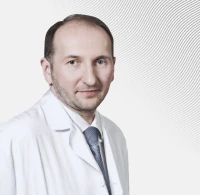The questions are answered by a neurosurgeon at the European Medical Center, Ph.D. Alexey Gaitan.
1. Do I need to operate on a herniated disc (protrusion)? Are all hernias operated on?
Hernias and protrusions of intervertebral discs are quite common, but not all patients need surgical treatment. This issue needs to be considered and resolved individually with each patient. First of all, the clinical picture of the disease and the patient's condition are important! In addition, it is important to assess the size of the hernia (protrusion), how it is located, what structures it affects, the size of the spinal canal, etc. In any case, a consultation with a neurosurgeon is necessary. Only a specialist can resolve the issue of indications for operations.
2. When should a herniated disc be operated on?
As a rule, the main indication for surgery is progressive neurological symptoms. It may be a pain syndrome that is resistant to conservative treatment for 5-8 weeks. Surgery may be necessary at an earlier date if severe leg pain is not relieved by modern medications, faceted and neuronal blocks. Progressive weakness in the leg (more often flexors and extensors of the foot) is also an indication for surgical treatment.
The appearance of pelvic organ dysfunction (impaired control of urination and defecation), weakness in the legs and decreased sensitivity in the anogenital area in the presence of a herniated disc are indications for immediate surgical treatment. All modern technologies of medical blockades and minimally invasive microsurgical and endoscopic treatment of patients with herniated discs are presented in our clinic.
3. What is intervertebral disc protrusion?
This is a protrusion of the intervertebral disc (nucleus pulposus) without rupture of the fibrous ring. Further progression of the disease leads to the degenerated nucleus pulposus bursting the fibrous ring. Extrusion and sequestration develop, with hernia fragments falling out into the spinal canal. Minimally invasive technologies can be used at the stage of intervertebral protrusion. In recent years, effective techniques have appeared, in particular, cold-plasma nucleoplasty used in our clinic, which allows through a puncture of the skin, without an incision, under X-ray control, to perform a procedure on the disc using a special electrode with a temperature at the tip of about 75 degrees.
At the same time, the disc decreases slightly in size, as if "shrinks", ceases to compress the nervous structures and, as a result, the pain syndrome passes. What is very important is that the protrusion does not increase in size and does not develop into a hernia that requires open surgery. However, it must be remembered that no surgical procedures can stop the degenerative process in the spine. The further fate of the patient depends on the entire rehabilitation complex and the patient's compliance with the orthopedic regime. Recommendations on hygiene of postures and movements are available at the link: http://sibneuro.ru/book.pdf
4. What is the danger of intervertebral disc protrusion?
Firstly, disc protrusion often causes pain in the lumbar spine that is resistant to conservative treatment.Secondly, disc protrusion often increases with time. After 3-5 years, without proper treatment and non-compliance with the orthopedic regime, a herniated disc in the form of extrusion and sequestration is already detected at the site of the protrusion. If the patient has a protrusion of the disc, surgery can currently be performed: cold plasma nucleoplasty.
5. What is spinal canal stenosis? Why is it dangerous and what should be done if such a diagnosis is made on an MRI (CT) scan?
Stenosis is a narrowing of the spinal canal. The spinal canal is a tube with an average diameter of 15 mm. There is a congenital wide spinal canal up to 20 mm. Usually, stenosis (absolute) is referred to when the narrowing of the spinal canal is less than 10 mm, relative stenosis is less than 12 mm. There are many causes of stenosis. This may be an innate feature of the body. It also happens that as a result of degenerative processes and spinal injuries, there is an increase in volume and ossification (ossification) of the intervertebral discs or joints of the spine. As a result, there is a narrowing of the spinal canal, that is, its stenosis.
6. What are the symptoms of spinal canal stenosis?
For a long time, stenosis does not manifest itself in any way. At a certain stage (this is individual), the patient experiences pains that vary in intensity and location. In some patients, weakness in the legs begins to progress, and weight loss of the legs is possible. A characteristic clinical sign of spinal canal stenosis is intermittent claudication. As time passes and the disease progresses, the patient can cover less and less distance without stopping and resting due to developing weakness in the legs.
7. What should I do if such a diagnosis is made on an MRI (CT) scan?
First of all, you need to consult a specialist, a spinal neurosurgeon. Whether it is necessary to operate, when and how is decided individually, but it is necessary to remember and understand that the main task of the operation is to stop the progression of weakness in the legs (legs and arms, if it is a stenosis of the cervical spine). Pain syndrome is also quite successfully treated surgically. Very often, patients arrive on crutches or are brought in a wheelchair. And in this situation, as a rule, it is possible to help, but, unfortunately, not always, especially if the weakness in the legs (or legs and arms) has been for a long time.
8. What is a vertebral body hemangioma? Why is it dangerous and what should be done if it is detected on an MRI (CT) scan?
This is a benign vascular neoplasm in the vertebral body. Hemangioma is more often found as an accidental finding during MRI (CT) for herniated discs, injuries, etc. First of all, the size of the hemangioma is important, as well as the progression of the size of the hemangioma (an MRI scan is performed after a year, preferably on the same device and it looks like it has increased or not). If the hemangioma is large enough (this is assessed by an MRI (CT) specialist and a spinal neurosurgeon), then the vertebra in which it is located may break even from a slight load, and this may require open surgery to stabilize the spine.
Hemangioma has another symptom. This does not always happen, but with large or growing hemangiomas it occurs quite often. This is a pain syndrome in the vertebra. As a rule, it is not very severe, but constant pain.
If this hemangioma is large, then there is a high risk of vertebral fracture. Currently, an operation has appeared that is performed through a puncture of the skin under X–ray control - vertebroplasty, that is, the introduction of a special medical bone cement into the vertebral body that strengthens the vertebra. The pain syndrome usually goes away. This operation is performed in our clinic.
9. What is osteoporosis? How does it manifest itself? What is dangerous and how to treat it?
Osteoporosis is a disease that causes bone tissue to lose its density. It most often occurs in women after menopause. Osteoporosis often occurs with the constant intake of hormonal drugs, for example, in patients with bronchial asthma or rheumatic diseases. Osteoporosis is often manifested by pain in the bones (spine, arms, legs). A complication of osteoporosis can be fractures of the bones of the limbs and vertebrae. Osteoporosis is usually treated by endocrinologists and therapists, there are drugs for its treatment and they are prescribed by specialists. In case of spinal fracture on the background of osteoporosis, a spinal neurosurgeon should be consulted to resolve the issue of its treatment. The technique of vertebroplasty - the injection of special medical bone cement through a skin puncture - has proven to be highly effective.








.webp)









